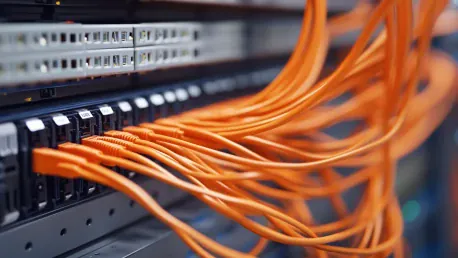A monumental breakthrough in quantum communication has been realized by scientists who successfully demonstrated quantum teleportation over fiber optic cables while concurrently streaming high-speed classical internet traffic. This remarkable development leverages the existing fiber optic infrastructure, eliminating the necessity for constructing new, specialized networks and paving the way for seamless integration of quantum systems into our current communication frameworks. Such advancements have far-reaching implications and could revolutionize fields like computing, cryptography, and sensing by enabling ultra-secure, high-speed communication over vast distances.
Integrating Quantum and Classical Signals
Traditional internet traffic utilizes millions of photons to encode data, whereas quantum communication harnesses single photons carrying intricate quantum states. This fundamental distinction poses significant challenges when attempting to share optical fibers with high-power classical signals, which can produce noise, particularly through spontaneous Raman scattering, and subsequently interfere with the delicate quantum signals. Over the years, extensive research has been dedicated to achieving quantum-classical coexistence, experimenting with various methodologies like weak coherent state sources, entangled photon pairs, and squeezed light. However, a majority of these efforts primarily concentrated on the direct transmission of quantum data between nodes.
New and emerging quantum applications, including quantum relays, repeaters, and networked quantum computers, depend heavily on the teleportation of quantum states without physical transmission. This innovative approach effectively circumvents the limitations associated with direct transmission and introduces new opportunities for integrating quantum communication into existing networks. The pressing challenge, however, has been to accomplish this without significant degradation of quantum signals due to interference from classical data traffic.
A Quantum Leap in Teleportation
Teleportation, facilitated through the phenomenon of quantum entanglement, enables a quantum state to be transferred non-locally between two distant systems. This unique property holds the potential to enable ultra-secure, high-speed communication across substantial distances, a feat that had yet to be demonstrated over fibers concurrently transmitting classical internet traffic. Engineers from Northwestern University have now achieved this milestone in a groundbreaking study published in the journal Optica.
Utilizing a three-node system stretched over 30.2 kilometers of fiber, the researchers successfully multiplexed quantum and classical signals using different wavelengths. Conducting a joint Bell state measurement (BSM) on a single photon and an entangled photon pair, the team successfully teleported the quantum state without notable degradation. This pioneering experiment marks a significant milestone in the practical implementation of quantum communication technologies and demonstrates the feasibility of quantum teleportation within existing fiber optic infrastructures.
Tackling Noise Challenges
To address noise challenges stemming from spontaneous Raman scattering and other interferences, the research team strategically selected wavelengths that minimize the risk of such issues. They positioned the quantum signals within the 1290-nanometer band, where scattering from high-power C-band light used for internet traffic is least likely to interfere. Employing narrow-band filtering and coincidence detection, the team further mitigated noise, ensuring high fidelity in the quantum state transfer.
The successful selection of wavelengths and implementation of advanced noise reduction techniques were critical to the achievement of this quantum teleportation. By circumventing the need to develop new infrastructure and instead optimizing existing frameworks, the researchers have significantly simplified the rollout of quantum technologies. This makes it more practical and feasible to integrate advanced quantum communication systems into our current network setups without incurring substantial costs or extensive labor.
Significance and Implications
Prem Kumar, the lead author of the study, underscored the importance of this achievement, noting that the integration of quantum and classical networks over existing fiber optic infrastructure opens new possibilities for advancing quantum communications. By selecting appropriate wavelengths, the researchers avoided the likelihood of needing to construct new infrastructure, greatly simplifying the deployment of quantum technologies. This breakthrough paves the way for a broad range of advanced applications, including quantum computing, impenetrable secure communications, and enhanced sensing capabilities.
To validate their proposed approach, the researchers put it to the test under real-world conditions. They successfully transmitted quantum data and high-speed internet traffic simultaneously through the same fiber optic cable. A photon carrying a quantum state was placed at one end of the 30-kilometer cable, while a photon entangled with the first was stationed at the other end. The quantum state was seamlessly teleported across the network, demonstrating that quantum and classical communications can coexist without mutual interference and verifying the practicality of their solution.
Future Innovations and Applications
Looking ahead, Kumar’s team plans to extend their testing to cover longer distances by incorporating two pairs of entangled photons to demonstrate entanglement swapping, a procedure crucial for distributed quantum applications. Additionally, they aim to transition from controlled laboratory environments to real-world settings, utilizing underground optical cables to bring this groundbreaking technology closer to practical and everyday use.
Kumar also emphasized that quantum teleportation has the potential to provide secure quantum connectivity between geographically distanced nodes. This study challenges the prevailing assumption that specialized infrastructure is mandatory to transmit particles of light, illustrating that classical and quantum communications can indeed coexist harmoniously. This advancement could lead to a significant simplification of quantum technology deployment, allowing existing fiber optic networks to support practical applications for a broad array of industries.
Conclusion
A groundbreaking achievement in quantum communication has been attained by scientists who have successfully demonstrated quantum teleportation via fiber optic cables while simultaneously transmitting high-speed classical internet traffic. This significant advancement makes use of the current fiber optic infrastructure, negating the need for building new, specialized networks. This is a key development because it facilitates the integration of quantum systems into existing communication frameworks without extensive modifications. The implications of this progress are vast, which could lead to a revolution in several fields such as computing, cryptography, and sensing. With the potential for ultra-secure, high-speed communication over long distances, these advancements could transform how we approach data transmission and security. Such integration promises to enhance the reliability and efficiency of networks, offering a new frontier of possibilities in the digital age. As we adopt these technologies, the landscape of global communication is poised for significant and positive change.









